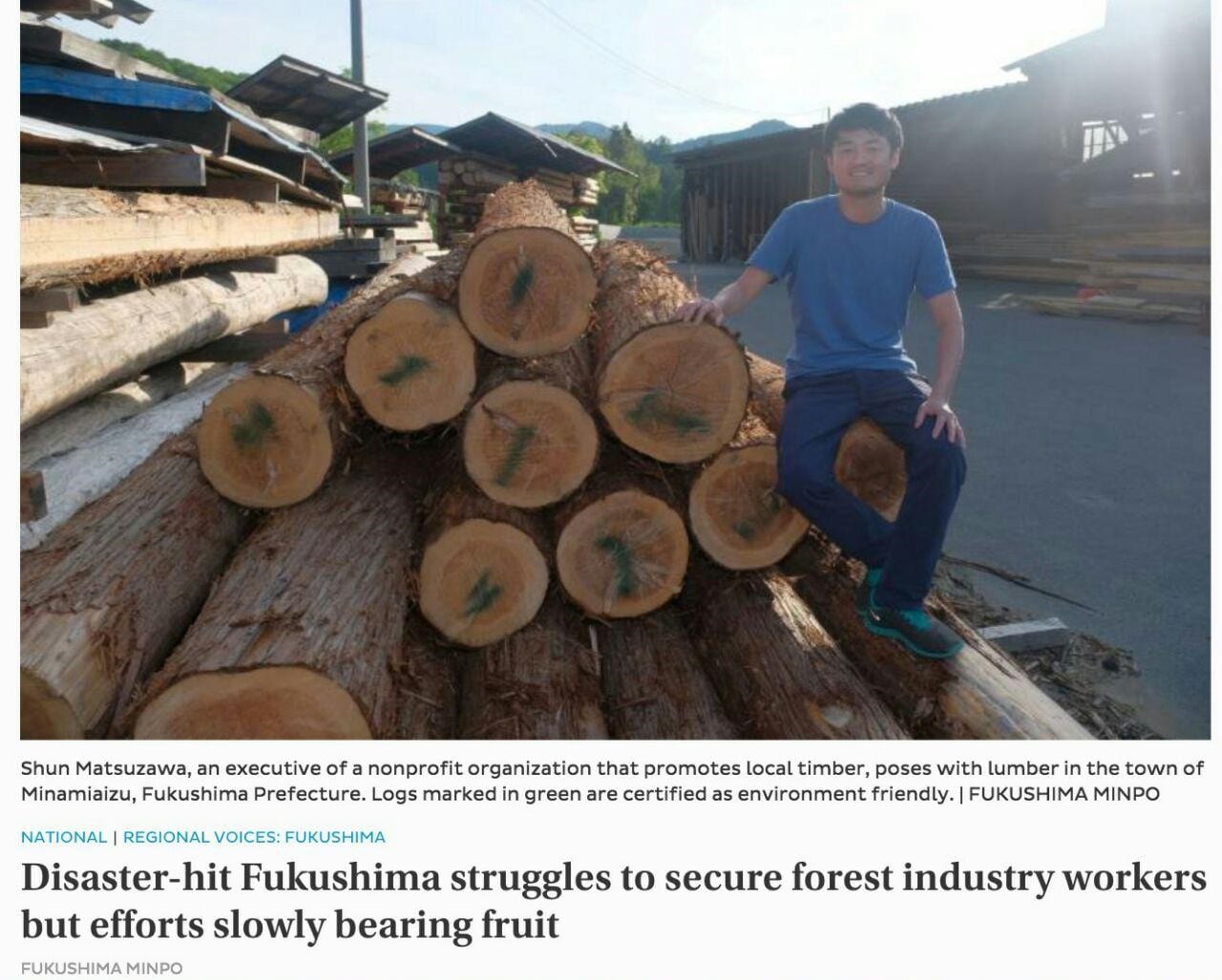Summary
The article was published on 15 June 2018 in The Japan Times and primarily depicts various efforts to revive the declining forest industry in the Fukushima Prefecture. The forest industry in Fukushima prefecture has been declining over the years for several reasons:
- Ageing population
- Many leaving the forest industry due to decline in timber prices
- Restricted zones set up after nuclear reactor meltdowns in 2011
The central problem the forest industry is now facing is a lack of young successors to revive forests.
Main local efforts to revive the forest industry are:
- Engaging local students
A local timber group in Iwaki (city in Fukushima) organises field trips for students to watch professionals’ jobs on-site, classes to give students experience in forestry, and public displays of handmade christmas trees and kadomatsu.

Kadomatsu (Fae’s Twist and Tango, 2012).
- Branding timber as environmental friendly
Local timber companies in Minamiaizu mark certified cedar logs in green to show that they are environmentally friendly. Certification is provided by the Sustainable Green Ecosystem Council (SGEC), “a third-party group in Japan that certifies timber from forests which clear specific criteria, including those where measurements are taken to maintain soil and water resources when trees are cut” (Disaster-hit Fukushima, 2018).
These efforts have achieved moderate success as some young people have joined the local timber group to become forest workers. Environmental-friendly certification has also helped, as timber from a local timber company has been shipped to Tokyo to build facilities for the 2020 Olympic games. However, challenges remain as the SGEC certification is not widely recognised and it has not promoted many shipments of lumber so far.
Representation of Japan and the environment
Japan is represented in this article as having a vast natural terrain of green, with “the Tabito district is known for rich forests which occupy 90 percent of its land”. Implicit in the whole article is the whole concept of Satoyama, which Catherine Knight (2010) defines as “the semi-managed, semi-cultivated area of woodland…surrounding human settlement”. While the forests in Fukushima Prefecture are not exactly “semi-managed, semi-cultivated” woodland, there is definitely a strong resounding theme of coexistence with the natural terrain, another idea central to the concept of Satoyama. In the article, humans are portrayed as sustaining and reviving the forests by engaging in operations such as thinning, while these forests sustain the livelihoods of local residents by being a source of timber to be sold.
What makes the subject “green”
As stated above, timber from Minamiaizu are branded as environmentally friendly. With the certification from SGEC, consumers become more aware of the environmental impacts of the forest industry. They can make more informed choices about the products they purchase and can choose to support sustainable brands such as those from Minamiaizu. Sustainability is extremely important especially in the forest industry as trees take a long term to regenerate and this is one of Fukushima’s most important resources (Disaster-hit Fukushima, 2018). If the trees are thinned out too rapidly, problems such as soil erosion and flooding downstream may occur. It is also important to ensure sustainability in the forest industry as forests play a huge role in cleaning up the atmosphere.
How this relates to ideas from class
Firstly, the article explores the relationship between nature and society. People working in the forest industry in Fukushima are working towards sustainability. This demonstrates the Japanese people’s control over resources and nature, while still respecting nature. They are willing to sacrifice short-term, immediate profits for long-term benefits to the environment, in order to sustain the industry for a longer period of time.
Secondly, this article is also reminiscent of forest management by younger workers in Tokyo Chainsaws. Due to the aging population and the nuclear meltdown in Fukushima in 2011, there is a lack of workers managing the forests. By introducing students to forest management in an effort to revive the forests, perhaps these students would take on roles similar to their Tokyo Chainsaws counterparts in the future.
Lastly, it is heartwarming to see Fukushima take steps in logging timber sustainably. As we have learnt in the roleplay exercise, over-logging not only affects those in the region, but may also affect Japanese people living in other regions. People living downstream may experience flooding, which may have negative impacts on their livelihoods.
A final word
It is essential to note the continual reference to “industry” throughout the entire article. Locals seem to be concerned with recruiting young workers only for the sake of boosting timber sales. It calls into question one of the fundamental assumptions of that this module also aim to address: the Japanese love for nature.
Word count: 764 words
References
Disaster-hit Fukushima struggles to secure forest industry workers but efforts slowly bearing fruit. (2018, June 15). Retrieved September 9, 2018, from https://www.japantimes.co.jp/news/2018/06/15/national/disaster-hit-fukushima-struggles-secure-forest-industry-workers-efforts-slowly-bearing-fruit/#.W5c4SOgzY2z
Iizuka, M. (2018, January 3). Forestry industry has growing appeal for Japan’s young women. Retrieved September 9, 2018, from https://www.japantimes.co.jp/news/2018/01/03/national/forestry-industry-growing-appeal-japans-young-women/#.W5c6legzY2w
Kadomatsu [Digital image]. (2012, December 30). Retrieved September 10, 2018, from https://fae-magazine.com/2012/12/31/japanese-new-year-oshogatsu/kadomatsu/
Knight, C. (2010). The Discourse of “Encultured Nature” in Japan: The Concept of Satoyama and its Role in 21st-Century Nature Conservation. Asian Studies Review, 34(4), 421-441. doi:10.1080/10357823.2010.527920
